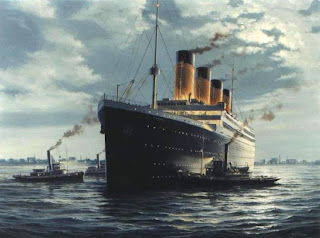
Location & Coordinates of the Wreck
-
The wreck of the Titanic lies in the North Atlantic Ocean, approximately 325 nautical miles (about 600 km) south‑southeast of Newfoundland, Canada.
-
It rests at a depth of about 12,500 feet (≈ 3,810 meters) below the ocean surface.
-
The two main parts of the wreck are separated: the bow section is relatively more intact, whereas the stern is heavily damaged. The debris field (scattered wreckage) spreads for miles around the main hull pieces.
Coordinates for the bow: 41° 43′ 57″ N, 49° 56′ 49″ W
Discovery & Exploration History
-
The wreck was discovered on September 1, 1985, by a joint American‑French expedition led by Robert Ballard & IFREMER, using submersible technology and remote cameras.
-
Since then, many expeditions have mapped and photographed the wreck using remotely operated vehicles (ROVs), autonomous underwater vehicles, and robotic cameras. A detailed archaeological map of the wreck site was produced using over 130,000 underwater images.
-
The wreck has been deteriorating over time: iron‑eating bacteria (including Halomonas titanicae) form rusticles; structural elements have collapsed (e.g. parts of railings) due to corrosion, pressure, and environmental conditions.
What Visitors & Tourists Should Know
Is It Possible to Visit?
-
Because the wreck is deep under the ocean (~3,800 m), it is not accessible for casual tourism. Visiting requires highly specialized submersibles, permits, considerable cost, and physical risk.
-
There are occasional submersible expeditions to the wreck site for research or special tourism, but these are rare, expensive, and subject to legal and ethical constraints.
Museums, Exhibitions & Alternative Visits
-
For most people, the way to “visit” or experience Titanic is through museums or exhibitions that display artifacts, recreations, and multimedia presentations. There are several well‑known Titanic exhibitions around the world.
-
Belfast (Northern Ireland) is a particularly significant location: Titanic was built there, and the Titanic Belfast museum in the Titanic Quarter has become a major tourist destination. Visitors can learn about the ship’s construction, life on board, its sinking, and its legacy.
Conservation & Significance
-
Because the shipwreck is considered a maritime grave (over 1,500 people lost), there are international laws, treaties, and agreements aimed at preserving the site and protecting it from unauthorized salvage or vandalism.
-
In 2012, the Titanic wreck became subject to protections under the UNESCO Convention on the Protection of Underwater Cultural Heritage. These aim to safeguard information, artifacts, and the integrity of the site.
Why the Titanic Still Captures the World’s Imagination
-
The scale of the disaster: the Titanic was considered state‑of‑the‑art, “unsinkable,” and luxurious, yet sank in dramatic fashion.
-
Personal stories: passengers from different classes, circumstances, acts of heroism and tragedy.
-
A lesson in engineering, safety regulations, and human hubris: the disaster led to changes in maritime safety (lifeboat requirements, iceberg patrols, radio use).
-
Cultural impact: books, films (including the famous 1997 Titanic), documentaries, art, exhibits.

Suggested Visitor Itinerary for Titanic Enthusiasts
If someone wants to explore Titanic historically and culturally (rather than physically dive to the wreck), here is a suggested itinerary:
| Location | What to See / Do |
|---|---|
| Belfast, Northern Ireland | Visit Titanic Belfast Museum. Tour the Titanic Quarter. Learn about the construction in Harland & Wolff shipyard. |
| Southampton / England | See departure point exhibitions, possibly memorials related to Titanic’s maiden voyage. Maritime museums often have related displays. |
| Newfoundland, Canada | Visit Myrick Wireless Interpretive Centre (Cape Race), which relates to the Titanic’s wireless distress signals. Also places like Halifax which played a rescue / recovery role. |
| Titanic Artifact Exhibits globally | Exhibits in Las Vegas (e.g. Titanic: The Artifact Exhibition), travelling exhibitions that show real artifacts from the wreck. |
| Documentation & Digital Media | Explore virtual/3D reconstructions of the wreck, guided tours online, documentaries that show recent mapping and conservation efforts. |
SEO Keywords & Tags to Include
To help this topic be discoverable online, these keywords and tags are useful to include naturally:
-
Titanic shipwreck
-
Titanic wreck location
-
Coordinates of Titanic wreck
-
RMS Titanic history
-
Titanic museum Belfast
-
Underwater cultural heritage
-
Titanic artifacts exhibition
-
Dive to Titanic
-
RMS Titanic discovery
Conclusion
The RMS Titanic remains one of the most iconic stories in maritime history. Though its remains lie two and a half miles beneath the North Atlantic, far beyond casual visitation, its legacy lives on through museums, exhibitions, documentaries, and ongoing scientific exploration. For tourists and history lovers, understanding where it rests, how it was discovered, and how it’s being preserved offers a meaningful way to connect with this tragic yet powerful chapter in human history.

You must be logged in to post a comment.